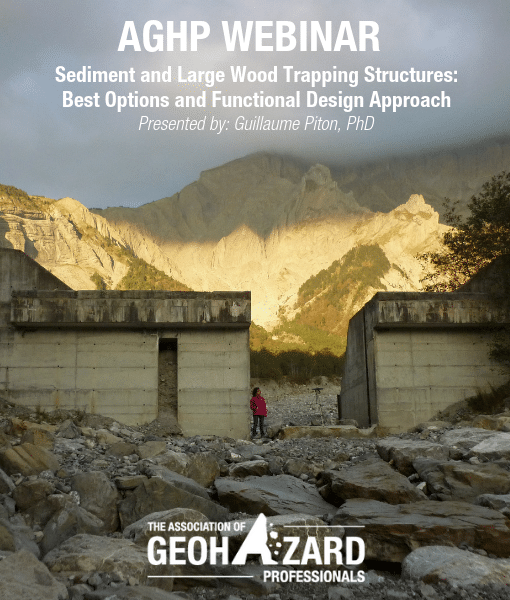View this webinar on-demand by logging into the Member Center. If you are not a member, we encourage you to join.
Sediment and Large Wood Trapping Structures:
Best Options and Functional Design Approach
Sediment and large wood trapping structures, also called SABO dams or open check dams, are regularly used in debris-flows and debris-flood mitigation schemes. They are very effective and efficient when used at appropriate sites and then correctly designed & maintained. Still, the processes occurring in these structures that result in the trapping of all or part of the solid load remain poorly understood. As a consequence, numerous structures are ill-designed generating high maintenance costs, the requirement for complementary works, and/or a higher likelihood of failure. Better understanding the driving mechanisms of deposition and erosion processes at the fan scale and at the structure scale may help design engineers to select the best type of structure for a given site and to design its shape and geometry in the most efficient manner.
This webinar will clarify the typical cascading processes resulting in deposition and flooding that are involved in interactions between fan channel and sediment & large wood-laden events. Those cascading processes make particular necessary changes in the debris-flows or debris-flood processes eventually using trapping structures or other structural measures. Participants will learn what can and cannot be achieved with open check dams, draw a simple portrait of the five main types of structures in relation with their particular function, and review the main existing design criteria helping to define the geometry of the dam and its basin.
This webinar is strictly dedicated to review and train engineers to decide whether or not trapping structures seem relevant for a given site and to perform the functional design of the basin and the open architecture, i.e., to define type, shape, and geometry. The webinar will not cover the structural design (impact forces, load scenario, internal and external stability) and will slightly cover the maintenance policy.

Presented By:

Guillaume Piton, Ph.D.
Researcher, Université Grenoble Alpes (France), Torrential Erosion, Snow Avalanche Research Unit, IRTSEA, Center of Grenoble
Dr. Piton has 10 years of experience in flood protection in mountain catchments. He holds a Master degree in civil engineering (2009) and a PhD in earth science (2016) from the Université Grenoble Alpes (France). He worked from 2009 to 2013 at ARTELIA, a large consulting company, designing flood protection systems and river restoration projects in the French Alps. Guillaume then joined his current research unit to perform research in hydraulics, steep creek geomorphology, solid transport and hazard mitigation in mountain catchments. His PhD thesis entitled "Sediment transport control by check dams and open check dams in Alpine torrents" focuses on the protection effectiveness of check dams and debris retention basins and was awarded the Jean Valemblois Award for best PhD thesis in fluid mechanics in 2017 by the French Hydrotechnic Association (SHF). Guillaume has co-authored more than 20 journal and conference papers on solid transport and mitigation measures. He also performs consulting and design studies of protection measures in France and Canada, and advises the French Ministry services in charge of flood risk on topics related to debris-flow and debris-flood hazards and risks.
